Quality Rating 2: Learning Materials
Instructions
To meet the requirements for Developmentally Appropriate Learning and Practice: Learning Materials: DAP 2.2, you will upload a statement that describes how your program selects and uses learning materials that:
- Are developmentally appropriate
- Are easy to access
- Reflect children’s interests
- Support children of all abilities
The Policy or Statement Builder provides a step-by-step guide for creating your statement.
Developmentally Appropriate
Children learn and develop by actively exploring their environment and interacting with materials that match their age and development. Because children grow and develop at different rates and at different times, it is important to provide a variety of toys and materials that allow all children to meet challenges, receive feedback, and experience success.

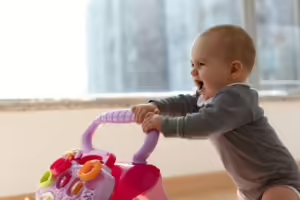
- How old are the children in your care?
- What skills are they working on?
- What materials will promote those skills?
- Will the materials challenge the children and encourage development?
- How do you include each developmental domain in the materials? (physical, language, cognitive, social emotional)
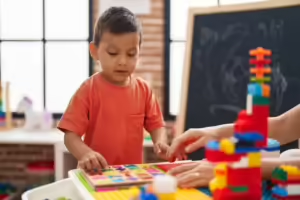

What does the documentation look like?
Your statement includes a description of how the materials and equipment you select and use in your program match the age and developmental levels of the children enrolled. You may use photographs from your environment to support your statement as a way of showing that your materials are appropriate and can be accessed by all children.
Easy to Access
All materials and equipment intended for children should be within their reach. Having materials that are easy to access encourages independence and responsibility particularly during free choice and clean-up activities. Low shelving for infants and toddlers allows the youngest of learners to access materials that interest them. Making adaptations can help ensure materials can be accessed by all children. For example, adding wooden blocks to tricycle peddles or adjusting the height of an easel can make a big difference in a child’s ability to participate fully in activities.
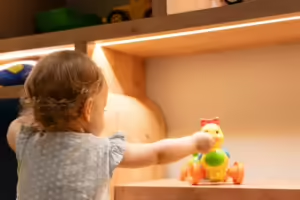
Can children reach the materials
on their own?

Are materials placed near children who are not yet mobile?

Can children clean up independently?

Have you adjusted materials so that all children may equally access them?
What does the documentation look like?
Your statement explains how materials and equipment can be accessed by all the children in your program.
Reflect Children’s Interests
Understanding children’s developmental levels, interests, and experiences helps you select materials that appeal to them and give them a sense of belonging and acceptance. For example, many young children enjoy dumping and filling activities. Sand tables, water play, and baskets of different toys all accommodate children’s interests in different ways. Include books and materials that build on children’s specific interests and experiences. Even the simplest material can spark rich conversation and promote language development, questions, and critical thinking.

What do the children love to do?
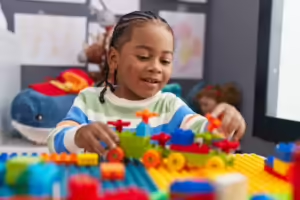
What captures their attention?
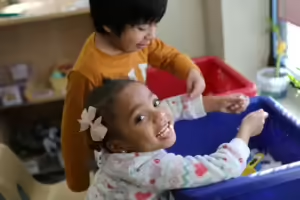
What materials spark the most excitement and conversation?
What does the documentation look like?
Your statement explains the many ways you choose materials that respect the children’s interests.
Support Children of all Abilities
Ensuring that every child has access to materials that support his or her ability is important when selecting toys and materials. Some children may be able to hold a regular cup, while others may need cups with handles. Traditional scissors may be appropriate for children with more experience, and spring scissors may help other children develop these skills. The important consideration is to assess and observe each child and ensure that materials and equipment allow all children to fully participate successfully in all aspects of your program.
- How will you use your observations of children to inform what materials you use with the children?
- How can you provide materials to support their growth?
- How do you decide what materials will challenge but not frustrate them?

What does the documentation look like?
Your statement includes a description of ways you select specific materials to support each child in your program. Consider including specific examples to support your statement.
Policy or Statement Builder
Develop a Statement that describes how your program selects and uses materials to support children’s learning. The Reflection Questions below will help you think about what you do in your program to capture it when creating your statement. Once you have spent time reflecting on the questions below, you’re ready to build your Selection and Use of Materials statement.
Reflection Questions
- How do you ensure that the materials selected and used are developmentally appropriate for the children enrolled in your program?
- Where do you keep your materials so that they can be accessed by children?
- How do you learn about the children’s preferences so that you choose materials that interest them?
- What kinds of materials do you have that support children of all abilities?
Optional for Level 2
- How do you select materials that promote multiple modes of exploration and learning? Give some examples.
- What kinds of materials do you select that reflect the children’s home languages and backgrounds?
- When and why do you rotate materials?
Did you know that if you include the Optional Level 2 Questions in your Statement that you may be approved for Level 5 in DAP 2?
Statement Builder Resources
Use these optional resources to reflect on your program’s practices and create your Selection and Use of Materials Statement.
Technology Tips
Choose the way that the provided resources will be most useful to you.
You can:
![]() Download the PDF.
Download the PDF.
![]() Save the PDF.
Save the PDF.
![]() Print the PDF.
Print the PDF.
![]() Edit the PDF.
Edit the PDF.


